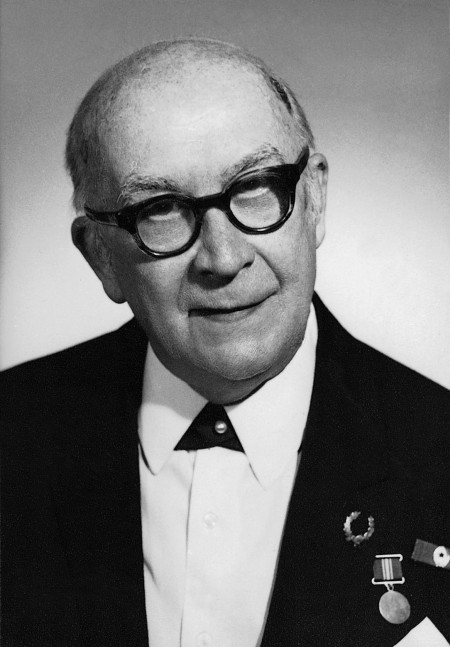
12 March 1900, Kecskemét - 25 January 1977, Budapest
Zoltán Vásárhelyi was a personality of great stature and impact of the Hungarian choral art. After his violin studies in his hometown he became a student at the violin division of the Hungarian Royal Academy of Music in the class of Rezső Kemény already in his senior high school year. Besides the violin teacher training he pursued with József Bloch he enrolled at the composition department as well, where he was a pupil of Leó Weiner and Zoltán Kodály except for a few classes taught by Albert Siklós. While fate brought that he gained reputation and world class artistic achievements by choral music (to which he later tied his life) and not by those fields he had pursued in official instruction. Without completing his composition studies (he finished that only by supplementary exams in 1941) he went to Estonia and later Norway to be an orchestral musician (his brother Ödön, also a violinist, settled in a Scandinavian country, as well).
The music school of his home town, still led by the follower and colleague in folk music collection of Bartók, the legendary Pál M. Bodon, who was also the director in Vásárhelyi's student years, invited him back to teach in 1926. We know from Vásárhelyi's remembrances that after his return he visited his composition professor to report on his experiences abroad. Kodály advised him: ‘found a choir!' That was a commitment for a lifetime which was enhanced by the experience that the sound of the female choir of the Kecskemét music school gave to the new-sprung choral conductor at the very first moment. Although he remained an active participant of the music life of the town in the Great Plain as a violinist and worked as a violin teacher for a long time, the choir became more and more in the focus of his interest and he found his way to the forefront of choral conductors by his talent and persistent self-training. He already organized a Kodály children's choir evening at the end of 1929 and the beginning of 1930. Later he took on Hungarian premieres of early masters' works, then premieres of great contemporary masters' compositions. The performance of the Matthew Passion by Schütz and the stage performance of Dido and Aeneas by Purcell in English (1933) worth mentioning among the former. From the latter the Öregek [Old People], the Akik mindig elkésnek [Too Late], the first performance of the Jézus és a kufárok [Jesus and the Trades] (with the Városi Dalárda [Town Choir] in the program of the Hírös Hét [Hírös Week] in Kecsekmét in 1934) and the premiere of the Molnár Anna were acts of music-historical significance. Among the works of Bartók, the Hungarian premieres of two movements of the Falun [Village Scenes] and three of the Magyar népdalok [Hungarian Folksongs] (1934 and 1936 respectively) and the organization of the premiere of a great portion of his works for equal voices (three of them were also conducted by him) are tied to Zoltán Vásárhelyi's name. According to Kodály's description his power to break unconcern made Vásárhelyi able to create a nationally renowned and exemplary choral life in Kecskemét.
Vásárhelyi became a teacher at the Academy of Music in 1941. At first he taught secondary violin, chamber music and score reading for students at singing teacher and high school teachers' training department. After 1945 choral conducting gained more and more ground in his college teaching and he became an influential professor of the subject from 1952 to the end of his life. Almost all of the most outstanding of the newer generations of choral conductors who earned international recognition for Hungarian choral art emerged from his school until the middle of the 1970s.
Besides college duties he was present in Hungarian musical life as an active choral conductor, as well. His selected workers' choir won first prize in Llangollen; a number of successful national and international appearances, including premieres of new works, as a leader of the Male Choir of Honvéd Artist Ensemble and the Choir of the Radio were tied to Vásárhelyi's name. The premiere of the Zrínyi szózata [Hymn of Zrínyi], a great a cappella cantata by Kodály in 1955, worth special mentioning. He enhanced his artistic reputation as the leader of the choir of the Academy of Music from 1959. Great oratorical concerts marked the harvest of his artistry: Bach Mass in B minor (1969), Schumann: Paradise and the Peri (1971).
The art of Zoltán Vásárhelyi was preserved on numerous radio and sound recordings including exemplary performances of works of Bartók and Kodály for a long time which express his artistic credo: the mental and emotional content provides the ground for the authentic performance which is conveyed by expressive and understandable articulation and vocal execution.
The artistic work of Zoltán Vásárhelyi was honored by numerous awards: Kossuth Prize (1949), Merited Artist Award (1955), the Award of the National Council of Trade Unions (1971).
I. M.


